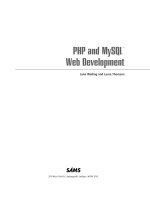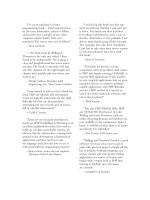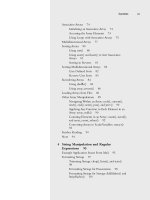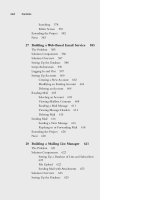PHP and MySQL Web Development - P76 pdf
Bạn đang xem bản rút gọn của tài liệu. Xem và tải ngay bản đầy đủ của tài liệu tại đây (100.07 KB, 5 trang )
347
Using Directory Functions
An associated and sometimes useful function is rewinddir($dir),which resets the
reading of filenames to the beginning of the directory.
As an alternative to these functions, you can use the dir class provided by PHP.This
has the properties handle and path, and the methods read(), close(), and rewind(),
which perform identically to the non-class alternatives.
Getting Info About the Current Directory
We can obtain some additional information given a path to a file.
The dirname($path) and basename($path) functions return the directory part of
the path and the filename part of the path, respectively.This could be useful for our
directory browser, particularly if we began to build up a complex directory structure of
content based on meaningful directory names and filenames.
We could also add to our directory listing an indication of how much space is left for
uploads by using the disk_free_space($path) function. If you pass this function a
path to a directory, it will return the number of bytes free on the disk (Windows) or the
file system (UNIX) that the directory is on.
Creating and Deleting Directories
In addition to passively reading information about directories, you can use the PHP
functions mkdir() and rmdir() to create and delete directories.You will only be able to
create or delete directories in paths that the user the script runs as has access to.
Using mkdir() is more complicated than you might think. It takes two parameters,
the path to the desired directory (including the new directory name), and the permis-
sions you would like that directory to have, for example,
mkdir("/tmp/testing", 0777);
However, the permissions you list are not necessarily the permissions you are going to
get.The current umask will be ANDed (like subtraction) with this value to get the actu-
al permissions. For example, if the umask is 022, you will get permissions of 0755.
You might like to reset the umask before creating a directory to counter this effect,
by entering
$oldumask = umask(0);
mkdir("/tmp/testing", 0777);
umask($oldumask);
This code uses the umask() function, which can be used to check and change the cur-
rent umask. It will change the current umask to whatever it is passed and return the old
umask, or if called without parameters, it will just return the current umask.
Note that the umask() function has no effect on Windows systems.
The rmdir() function deletes a directory, as follows:
rmdir("/tmp/testing");
21 525x ch16 1/24/03 3:41 PM Page 347
348
Chapter 16 Interacting with the File System and the Server
or
rmdir("c:\\tmp\\testing");
The directory you are trying to delete must be empty.
Interacting with the File System
In addition to viewing and getting information about directories, we can interact with
and get information about files on the Web server.We’ve previously looked at writing to
and reading from files. A large number of other file functions are available.
Get File Info
We can alter the part of our directory browsing script that reads files as follows:
while ($file = $dir->read())
{
echo '<a href="filedetails.php?file='.$file.'">'.$file.'</a><br />';
}
We can then create the script filedetails.php to provide further information about a
file.The contents of this file are shown in Listing 16.4.
One warning about this script: Some of the functions used here are not supported
under Windows, including posix_getpwuid(), fileowner(),and filegroup(),orare
not supported reliably.
Listing 16.4 filedetails.php—File Status Functions and Their Results
<html>
<head>
<title>File Details</title>
</head>
<body>
<?php
$current_dir = '/uploads/';
$file = basename($file); // strip off directory information for security
echo '<h1>Details of file: '.$file.'</h1>';
$file = $current_dir.$file;
echo '<h2>File data</h2>';
echo 'File last accessed: '.date('j F Y H:i', fileatime($file)).'<br />';
echo 'File last modified: '.date('j F Y H:i', filemtime($file)).'<br />';
$user = posix_getpwuid(fileowner($file));
echo 'File owner: '.$user['name'].'<br />';
21 525x ch16 1/24/03 3:41 PM Page 348
349
Interacting with the File System
$group = posix_getgrgid(filegroup($file));
echo 'File group: '.$group['name'].'<br />';
echo 'File permissions: '.decoct(fileperms($file)).'<br />';
echo 'File type: '.filetype($file).'<br />';
echo 'File size: '.filesize($file).' bytes<br />';
echo '<h2>File tests</h2>';
echo 'is_dir: '.(is_dir($file)? 'true' : 'false').'<br />';
echo 'is_executable: '.(is_executable($file)? 'true' : 'false').'<br />';
echo 'is_file: '.(is_file($file)? 'true' : 'false').'<br />';
echo 'is_link: '.(is_link($file)? 'true' : 'false').'<br />';
echo 'is_readable: '.(is_readable($file)? 'true' : 'false').'<br />';
echo 'is_writable: '.(is_writable($file)? 'true' : 'false').'<br />';
?>
</body>
</html>
The results of one sample run of Listing 16.4 are shown in Figure 16.4.
Listing 16.4 Continued
Figure 16.4 The File Details view shows file system information about a file.
Note that permissions are shown in an octal format.
21 525x ch16 1/24/03 3:41 PM Page 349
350
Chapter 16 Interacting with the File System and the Server
Let’s talk about what each of the functions used in Listing 16.4 does.
As mentioned previously, the basename() function gets the name of the file without
the directory. (You can also use the dirname() function to get the directory name with-
out the filename.)
The fileatime() and filemtime() functions return the time stamp of the time the
file was last accessed and last modified, respectively.We’ve reformatted the time stamp
using the date() function to make it more human-readable.These functions will return
the same value on some operating systems (as in the example) depending on what infor-
mation the system stores.
The fileowner() and filegroup() functions return the user ID (uid) and group ID
(gid) of the file.These can be converted to names using the functions posix_getp-
wuid() and posix_getgrgid(),respectively, which makes them a bit easier to read.
These functions take the uid or gid as a parameter and return an associative array of
information about the user or group, including the name of the user or group, as we
have used in this script.
The fileperms() function returns the permissions on the file.We have reformatted
them as an octal number using the decoct() function to put them into a format more
familiar to UNIX users.
The
filetype() function returns some information about the type of file being
examined.The possible results are fifo, char, dir, block, link, file, and unknown.
The filesize() function returns the size of the file in bytes.
The second set of functions—is_dir(), is_executable(), is_file(), is_link(),
is_readable(), and is_writable()—all test the named attribute of a file and return
true or false.
We could alternatively have used the function stat() to gather a lot of the same
information.When passed a file, this returns an array containing similar data to these
functions.The lstat() function is similar, but for use with symbolic links.
All the file status functions are quite expensive to run in terms of time.Their results
are therefore cached. If you want to check some file information before and after a
change, you need to call
clearstatcache();
in order to clear the previous results. If you wanted to use the previous script before and
after changing some of the file data, you should begin by calling this function to make
sure the data produced is up-to-date.
Changing File Properties
In addition to viewing file properties, we can alter them.
Each of the chgrp(file, group), chmod(file, permissions), and
chown(file, user) functions behaves similarly to its UNIX equivalent. None of
these will work in Windows-based systems, although chown() will execute and always
return true.
21 525x ch16 1/24/03 3:41 PM Page 350
351
Interacting with the File System
The chgrp() function is used to change the group of a file. It can only be used to
change the group to groups of which the user is a member unless the user is root.
The chmod() function is used to change the permissions on a file.The permissions
you pass to it are in the usual UNIX chmod form—you should prefix them with a "0"
to show that they are in octal, for example,
chmod('somefile.txt', 0777);
The chown() function is used to change the owner of a file. It can only be used if the
script is running as root, which should never happen.
Creating, Deleting, and Moving Files
You can use the file system functions to create, move, and delete files.
First, and most simply, you can create a file, or change the time it was last modified,
using the touch() function.This works similarly to the UNIX command touch.The
function has the following prototype:
int touch (string file, [int time [, int atime]])
If the file already exists, its modification time will be changed either to the current time,
or the time given in the second parameter if it is specified. If you want to specify this, it
should be given in time stamp format. If the file doesn’t exist, it will be created.The
access time of the file will also change: by default to the current system time or alterna-
tively to the time stamp you specify in the optional
atime parameter.
You can delete files using the unlink() function. (Note that this function is not
called delete—there is no delete.) You use it like this:
unlink($filename);
This is one of the functions that doesn’t work with some older Windows versions.
However, if it doesn’t work on your setup, you can delete a file in Windows with
system("del filename.ext");
You can copy and move files with the copy() and rename() functions, as follows:
copy($source_path, $destination_path);
rename($oldfile, $newfile);
You might have noticed that we used copy() in Listing 16.2.
The rename() function does double duty as a function to move files from place to
place because PHP doesn’t have a move function.Whether you can move files from file
system to file system, and whether files are overwritten when rename() is used is operat-
ing system dependent, so check the effects on your server.Also, be careful about the path
you use to the filename. If relative, this will be relative to the location of the script, not
the original file.
21 525x ch16 1/24/03 3:41 PM Page 351









